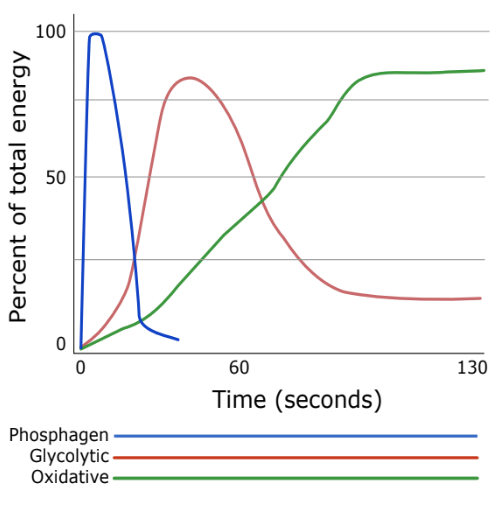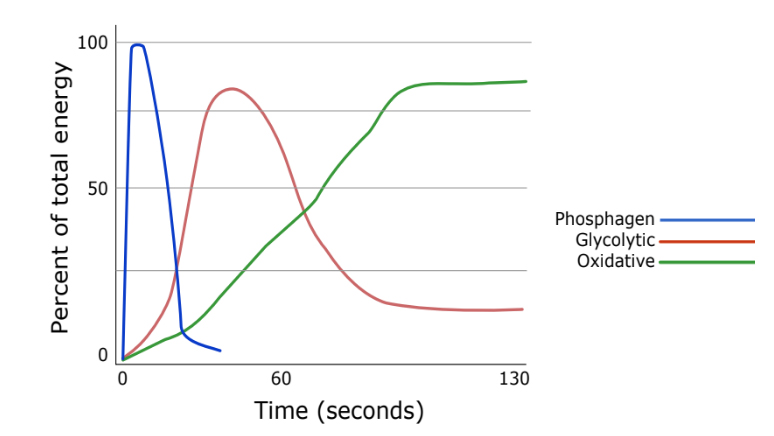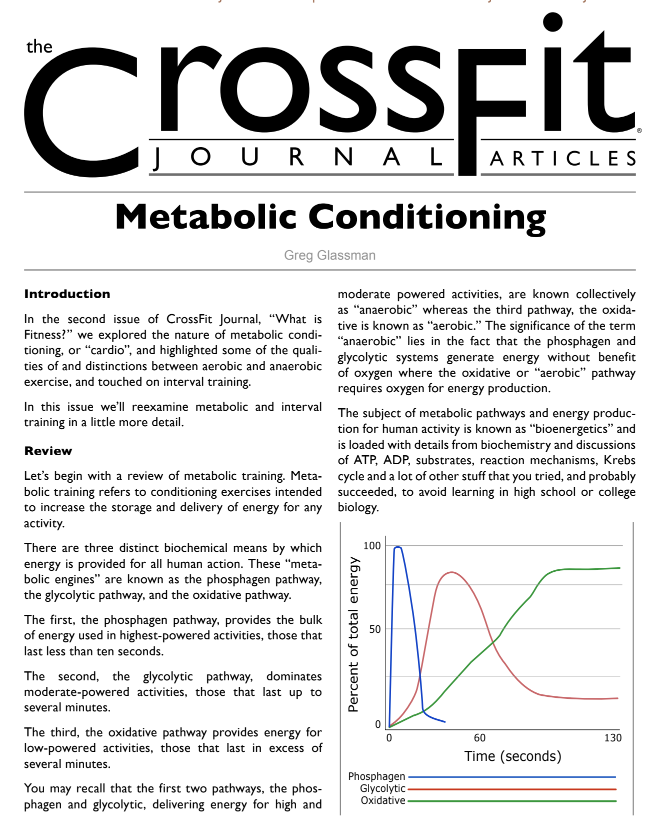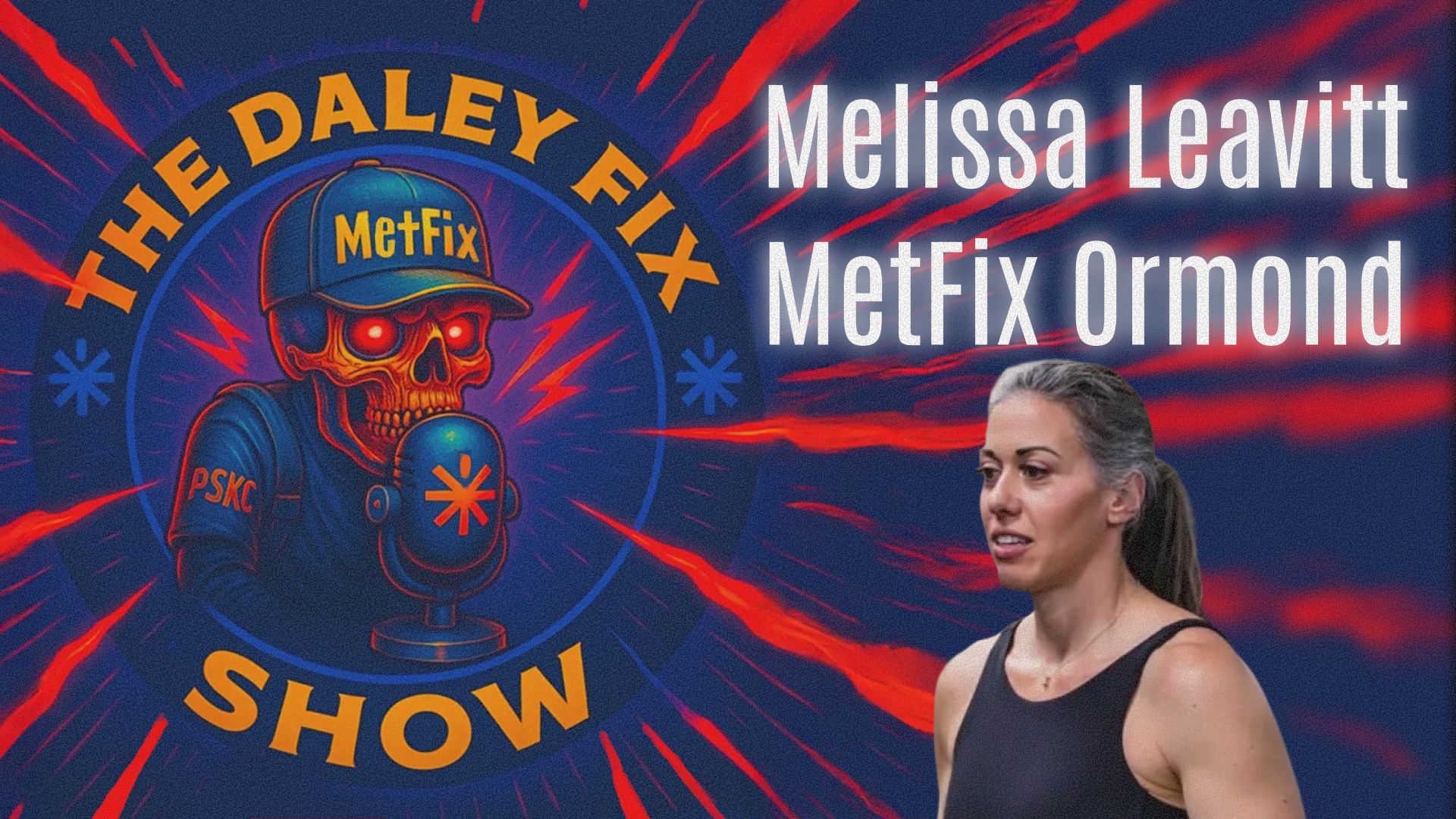Introduction
In the second issue of CrossFit Journal, “What is Fitness?,” we explored the nature of metabolic conditioning, or “cardio”, and highlighted some of the qualities of and distinctions between aerobic and anaerobic exercise, and touched on interval training. In this issue we’ll reexamine metabolic and interval training in a little more detail.
Review
Let’s begin with a review of metabolic training. Metabolic training refers to conditioning exercises intended to increase the storage and delivery of energy for any activity.
There are three distinct biochemical means by which energy is provided for all human action. These “metabolic engines” are known as the phosphagen pathway, the glycolytic pathway, and the oxidative pathway.
The first, the phosphagen pathway, provides the bulk of energy used in highest-powered activities, those that last less than ten seconds.
The second, the glycolytic pathway, dominates moderate-powered activities, those that last up to several minutes.
The third, the oxidative pathway provides energy for low-powered activities, those that last in excess of several minutes.

You may recall that the first two pathways, the phosphagen and glycolytic, delivering energy for high and moderate powered activities, are known collectively as “anaerobic” whereas the third pathway, the oxidative is known as “aerobic.” The significance of the term “anaerobic” lies in the fact that the phosphagen and glycolytic systems generate energy without benefit of oxygen where the oxidative or “aerobic” pathway requires oxygen for energy production.

The subject of metabolic pathways and energy production for human activity is known as “bioenergetics” and is loaded with details from biochemistry and discussions of ATP, ADP, substrates, reaction mechanisms, Krebs cycle and a lot of other stuff that you tried, and probably succeeded, to avoid learning in high school or college biology.
If you feel the compulsion to learn more on the biochemistry of bioenergetics, many resources are available online.
Anaerobics and Aerobics Made Simple
Our purpose in this issue of CrossFit Journal is to avoid the complexities and nuances of molecular biochemistry and render a useable foundation for understanding “cardio” and specifically the CrossFit approach to conditioning.
To that end we will forego considerations other that the sustainability of maximum efforts and, so, concern ourselves with all out efforts of varying durations and ignore issues of power, pathways, and energy production.
We only need to remember that anaerobic exercise is metabolically unsustainable exercise whereas aerobic exercise is sustainable. Sustainability is the key.
Generally, all out efforts of two minutes or less are anaerobic while efforts lasting more than several minutes are aerobic.
Reducing the whole of bioenergetics to this level isn’t just convenient it allows for examination at a level of granularity that allows for maximum useful understanding of metabolic conditioning. Biochemists, while able to recite intricacies of energy substrates and ATP production are all too often blind to the interplay of varying exercise protocols and their resulting fitness.
A metaphor may aid in understanding our position on the science of bioenergetics. We are striving to give you a racecar driver’s sense of auto racing not a mechanical engineer’s. Both have their place but only one drives the car on race day.
Anaerobic efforts are relatively high powered, and aerobic efforts are relatively low powered. This should be self evident from our understanding that anaerobic work is unsustainable past several minutes. It would be hard to escape the observation that power, or intensity, and duration of effort are inversely related. One hundred meter dash pace is a considerably faster pace than a mile pace.

Aerobic exercise is nearly universally regarded as being heart protective, but there is compelling evidence that shows that anaerobic exercise is at least as heart protective as aerobic exercise.
Though aerobic exercise is widely recognized as being the ideal vehicle for fat loss, recent studies have shown that anaerobic exercise is a vastly superior protocol for fat burning.
Anaerobic exercise builds muscle; aerobic exercise burns muscle – period. On this point there is no intelligent debate. Compare the look of sprinters to long distance runners – here a picture is indeed worth a thousand words.
The muscle wasting nature of aerobic exercise is both cause and symptom of the deleterious effect that endurance work can have on anaerobic performance. Sadly, this lesson has been slow to spread to many anaerobic sports. It is still common to find boxers and other martial artists who think that long slow endurance work – roadwork – is essential to their fight endurance. Nothing could be further from the truth.
On the other hand anaerobic training is of enormous benefit to endurance athletes. Not only does it support and build muscle, but it gives the “kick” needed to win close races. Importantly, not only does anaerobic work benefit aerobic performance, but anaerobic training can be used to develop high levels of aerobic fitness without the usual muscle wasting. This is accomplished through interval training and is an integral part of sports training for most sports.
Interval Training
Interval training alternates bouts of high intensity work with rest in repeated timed intervals. The general idea is to perform a high volume of high intensity work in a limited time. Ultimately, it is nothing more than anaerobic training with controlled rest periods.
The benefits of interval training are to both anaerobic and aerobic systems. The obvious question is how much benefit and to which system?
We can orchestrate intervals so that they predominantly stress either aerobic or anaerobic systems. The table below gives interval strategies to target desired metabolic systems.
But, even more interesting is the prospect of a hybrid interval that would greatly stress and thereby substantially condition both anaerobic and aerobic systems simultaneously. Finding such an interval and demonstrating its dual potency would be a great find.
It may have been done.
Tabata Interval
Dr. Izumi Tabata experimented with intervals and published in the journal Medicine in Sports and Exercise the results of an experiment in which he produced excellent improvements in anaerobic and aerobic conditioning in a group of accomplished athletes with a four minute (3:50) protocol of 20 seconds of all out work followed by 10 seconds of rest repeated 8 times.
Significantly, Dr. Tabata’s 4 minute high intensity group got better V02 max improvement than the control group, which followed a 60 minute moderate intensity regimen.
Clarence Bass and Peak Performance both give great accounts of Dr. Tabata’s research and understand the important implications.
Tabata Applications
Dr. Tabata’s research subjects exercised on stationary bikes; we decided to test other applications.
Our favorite and most effective application has been the “Tabata” squat – a 20 seconds on, 10 seconds off repeated 8 times squatting effort scored by the lowest number of reps performed in any of the eight intervals.
This single drill tests for and develops elite athletic capacities. Rankings for this drill accurately predict ranking performance on a wide variety of fundamental athletic skills and performance.
Another of our crew’s favored applications is to use the Tabata interval in a workout where an athlete moves from the Concept II Rower to squats then pull-ups, situps, and push-ups. Each exercise is performed like the Tabata squat – 20 on/10 off X 8. Adding the weakest link from each exercise tabulates a final score. The Rowing is scored in “calories” and the other events by reps. We allow a minute’s break between exercises.
Both of these simple workouts are very demanding and surprisingly potent. Trying either will convince you of their potency. Our experience is that improvements in scores for both Tabata workouts suggest strongly that an athlete is likely to show substantial improvements wherever we test them.
Try the Tabata workouts, experiment with varying interval design, and repeat noticeably difficult protocols from time to time. Trust that particularly challenging efforts speak directly to your opportunities for physical gains, and that improved performance in those efforts is the best measure of those gains. Chase the toughest intervals.
The most important point to remember is that high intensity efforts can produce dramatic aerobic benefit without the muscle wasting seen with endurance training.
Dr. Stephen Seiler on Intervals and Endurance Work
Dr. Seiler is a renowned exercise physiologist and rowing coach. In a piece entitled “Understanding Intervals” Dr. Seiler explains that there are winning rowing programs that train all intervals as well as those that do some, and programs that do none. Each approach has been shown to produce winners.
Dr. Seiler has concerns about the wisdom of programs that do too much interval work only because intervals may produce what he calls first and second wave adaptation to endurance training but not third wave adaptations. Third wave adaptations are largely specific to the training modality, and have nothing to do with aerobic conditioning but endurance performance. The difference is critical. But do we want third wave adaptations?
Third wave gains in endurance performance are entirely specific to that sport and have training effects disadvantageous to much of other sport performance.
Dr. Seiler’s admission that elite aerobic performance can be trained by high intensity intervals and his concerns that intervals don’t produce third wave adaptations form a terrific rationale for avoiding steady state aerobic work.
The idea that later adaptations to endurance work are highly specific to the training modality and portend little impetus to further cardiovascular development hints at the possibilities for generating additional cardiovascular benefit by means of shifting training modalities sufficiently to avoid “third wave” adaptations and focus instead on 1st and 2nd wave adaptations from a multitude of protocols and modalities. Our hope and suspicion is that this broadens the cardiovascular stimulus.
Our Position
As ridiculous as the idea that extended endurance efforts optimally confer cardiovascular and fitness benefits is the notion that a stressor like a bike is good “cardio” whereas a kettlebell, obstacle course, or CrossFit-like workout performed at similar exertion levels carries a lesser cardiovascular benefit!
Ultimately our position on metabolic conditioning, or “cardio”, is summed in two points:
- Anaerobic training can match endurance training for aerobic benefit.
- Metabolic training with varying and mixed exercise modalities avoids specificity of adaptation allowing for additional first wave – cardiovascular/ respiratory adaptations, and increased functional strength.
The clincher is that CrossFit athletes have demonstrated improved endurance performance without endurance training, and even more amazingly, in clinical trials CrossFit’s high intensity regimen has produced improvements in endurance measures that rivaled those achieved through programs comprised largely of endurance efforts.
Police training programs in Florida have found that CrossFit produced better distance run times than prior programs comprised largely of distance runs.
CrossFit athletes live in a steady state of physical preparedness that leaves them primed for specialized training and unknown physical challenges regardless of whether the demands are aerobic, anaerobic, or both.
There are cars that get 100 miles to the gallon. They are low powered, slow, and fuel-efficient. Others cars are high powered and fast while being less fuel-efficient. CrossFit is building powerful fast athletes not slow, low powered, fuel-efficient athletes.
Athletes that train predominantly anaerobic pathways in a wide range of intervals and modalities have at least the cardiovascular or aerobic fitness of endurance athletes.
This article, by BSI’s co-founder, was originally published in The CrossFit Journal. While Greg Glassman no longer owns CrossFit Inc., his writings and ideas revolutionized the world of fitness, and are reproduced here.
Coach Glassman named his training methodology ‘CrossFit,’ which became a trademarked term owned by CrossFit Inc. In order to preserve his writings in their original form, references to ‘CrossFit’ remain in this article.
Greg Glassman founded CrossFit, a fitness revolution. Under Glassman’s leadership there were around 4 million CrossFitters, 300,000 CrossFit coaches and 15,000 physical locations, known as affiliates, where his prescribed methodology: constantly varied functional movements executed at high intensity, were practiced daily. CrossFit became known as the solution to the world’s greatest problem, chronic illness.
In 2002, he became the first person in exercise physiology to apply a scientific definition to the word fitness. As the son of an aerospace engineer, Glassman learned the principles of science at a young age. Through observations, experimentation, testing, and retesting, Glassman created a program that brought unprecedented results to his clients. He shared his methodology with the world through The CrossFit Journal and in-person seminars. Harvard Business School proclaimed that CrossFit was the world’s fastest growing business.
The business, which challenged conventional business models and financially upset the health and wellness industry, brought plenty of negative attention to Glassman and CrossFit. The company’s low carbohydrate nutrition prescription threatened the sugar industry and led to a series of lawsuits after a peer-reviewed journal falsified data claiming Glassman’s methodology caused injuries. A federal judge called it the biggest case of scientific misconduct and fraud she’d seen in all her years on the bench. After this experience Glassman developed a deep interest in the corruption of modern science for private interests. He launched CrossFit Health which mobilized 20,000 doctors who knew from their experiences with CrossFit that Glassman’s methodology prevented and cured chronic diseases. Glassman networked the doctors, exposed them to researchers in a variety of fields and encouraged them to work together and further support efforts to expose the problems in medicine and work together on preventative measures.
In 2020, Greg sold CrossFit and focused his attention on the broader issues in modern science. He’d learned from his experience in fitness that areas of study without definitions, without ways of measuring and replicating results are ripe for corruption and manipulation.
The Broken Science Initiative, aims to expose and equip anyone interested with the tools to protect themself from the ills of modern medicine and broken science at-large.
Support the Broken Science Initiative.
Subscribe today →
recent posts
Medical Society Webinar with David Wiss




